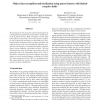Free Online Productivity Tools
i2Speak
i2Symbol
i2OCR
iTex2Img
iWeb2Print
iWeb2Shot
i2Type
iPdf2Split
iPdf2Merge
i2Bopomofo
i2Arabic
i2Style
i2Image
i2PDF
iLatex2Rtf
Sci2ools
IJCV
2008
2008
Object Class Recognition and Localization Using Sparse Features with Limited Receptive Fields
We investigate the role of sparsity and localized features in a biologically-inspired model of visual object classification. As in the model of Serre, Wolf, and Poggio, we first apply Gabor filters at all positions and scales; feature complexity and position/scale invariance are then built up by alternating template matching and max pooling operations. We refine the approach in several biologically plausible ways. Sparsity is increased by constraining the number of feature inputs, lateral inhibition, and feature selection. We also demonstrate the value of retaining some position and scale information above the intermediate feature level. Our final model is competitive with current computer vision algorithms on several standard datasets, including the Caltech 101 object categories and the UIUC car localization task. The results further the case for biologically-motivated approaches to object classification.
| Added | 12 Dec 2010 |
| Updated | 12 Dec 2010 |
| Type | Journal |
| Year | 2008 |
| Where | IJCV |
| Authors | Jim Mutch, David G. Lowe |
Comments (0)

